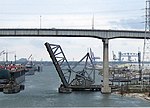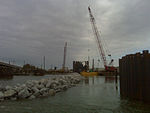Industrial Canal

The Industrial Canal is a 5.5 mile (9 km) waterway in New Orleans, Louisiana, United States. The waterway's proper name, as used by the U.S. Army Corps of Engineers and on NOAA nautical charts, is Inner Harbor Navigation Canal (IHNC). The more common "Industrial Canal" name is used locally, both by commercial mariners and by landside residents.The canal connects the Mississippi River to Lake Pontchartrain. It separates New Orleans East from the rest of the city, and the Lower 9th Ward from the Upper 9th Ward. Approximately half of the waterway's course, from Industrial Lock to a point north of the Florida Avenue Bridge, is confluent with both the Gulf Intracoastal Waterway and the Mississippi River Gulf Outlet (MRGO). The entirety of the canal passes through the 9th Ward of the city. Along the riverfront, the canal constitutes the boundary of the Upper 9th Ward on the upriver side of the canal and the Lower 9th Ward neighborhood on the downriver side. Near the lake, it is generally considered to be the eastern boundary of the Gentilly neighborhood and the western boundary of New Orleans East.
Excerpt from the Wikipedia article Industrial Canal (License: CC BY-SA 3.0, Authors, Images).Industrial Canal
New Orleans
Geographical coordinates (GPS) Address Nearby Places Show on map
Geographical coordinates (GPS)
| Latitude | Longitude |
|---|---|
| N 30.01567 ° | E -90.02927 ° |
Address
70126 New Orleans
Louisiana, United States
Open on Google Maps









